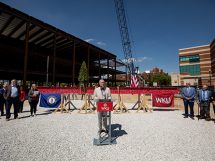 While the news media is treating the current partial shutdown of the federal government as if it is a rare, once-in-a-lifetime event, national government shutdowns have occurred fairly regularly in recent times during the administrations of numerous presidents of both political parties. Presidents Reagan, Bush, Clinton, Obama and Trump all experienced shutdowns. These most frequently occur when Congress fails to agree on spending in the budget bill.
While the news media is treating the current partial shutdown of the federal government as if it is a rare, once-in-a-lifetime event, national government shutdowns have occurred fairly regularly in recent times during the administrations of numerous presidents of both political parties. Presidents Reagan, Bush, Clinton, Obama and Trump all experienced shutdowns. These most frequently occur when Congress fails to agree on spending in the budget bill.
The primary job of the United States Congress is to pass a budget, the road map for operating the national government. Yet once again, at Christmastime the Senate rushed through a stop-gap spending bill to keep the government running and open, because it had failed to approve a budget on time. A January 2018 report from Pew Research Center documents that “in the four decades since the current system for budgeting and spending tax dollars has been in effect, Congress has managed to pass all its required appropriations measures on time only four times: In fiscal 1977 (the first full fiscal year under current system), 1989, 1995 and 1997.”
That amounts to Congress doing its primary job of passing a budget on time only 10 percent of the time.
In addition to uncertainty and the failure to properly appropriate Congress’ spending, the current work-around process also makes it even more difficult to identify ways to thoughtfully reduce a $1 trillion deficit and a $22 trillion national debt. This exemplifies what experts mean when they say “the budget process is broken.”
Without serious budget reform to avoid this pattern of short-term measures and “continuing resolutions” as the process for budget formation, funding will continue to be chaotic. This pattern of budget preparation by Congress creates frequent possibilities for government shutdowns since 75 percent of the nation’s budget is already funded for mandatory programs such as Social Security, Medicare, Medicaid, interest payments on the debt and six federal departments that include the Defense Department.
Each year, the only spending under Congress’ full purview – so called “discretionary spending” – becomes a smaller and smaller share of the whole budget. For instance, in 1970, the discretionary spending share of the whole budget was 62 percent. Today, it is down to 30 percent. Therefore, every member of the Congress is fighting to get his/her priorities funded from this smaller discretionary spending pot.
The automatic growth of the mandated programs eats up the lion’s share of available funds, along with pet projects that exceed available funds. When you are out of money and fail to agree on discretionary spending proposals, that produces a process spiraling even more out of control. It is why the government always seems on the brink of shutting down and why the national debt continues to escalate.
While it is a complex problem with no easy choices in sight, Congress must address the automatic mandatory spending for entitlements along with other reforms. Otherwise, the nation will continue to face federal government shutdowns and the budgetary chaos that exists year in and year out. Fundamental fiscal reform is never easy, but is necessary for sound spending policy.
In all its coverage of shutdowns, it would be useful for the media to explain that there presently is (or has been) a partial shutdown with essential areas of government operating normally. Seventy-five percent of the budget is already funded. And while certainly impactful – especially for the employees involved and their families – a partial shutdown is occurring throughout nonessential functions. ■
Pat Freibert is a former Kentucky state representative from Lexington. She can be reached at [email protected].




















Add Comment